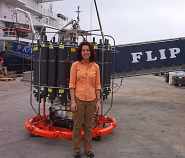|
Ocean
Exploration - Chapter Two
In September
we began a series of Habitat of the Month articles featuring
oceans with Oceans - Chapter 1. This month we pick-up the
oceans theme again with Chapter 2 and a continued focus on
exploration of our oceans.
Teacher
at Sea - Debra Brice, USA
Hi, my
name is Debra Brice and I am an 8th grade science teacher
at San Marcos Middle School in California, USA. I have been
selected as a NOAA (National Oceanographic and Atmospheric
Administration) 'Teacher at Sea' along with another teacher
from Chile.
The ship
on which we will be travelling is a Scripps Institution of
Oceanography R/V Roger Revelle. The chief scientist for this
research cruise, Dr. Robert Weller, is from WHOI (Woods Hole
Oceanographic Institution). The Chilean teacher and I will
be flying to Ecuador at the beginning of November to meet
the ship and leave Manta, Ecuador on November 9th. We steam
800 miles south-west off the coast of Chile to some carry
out physical Oceanographic research related to the deployment
of a Weather and Acoustical Buoy for WHOI, then we go in towards
the coast to deploy a Tsunami detection Buoy for NOAA.
|

Debra
Brice in front of the R/V Revelle
on Sept 23, 2003
|
Science
Goals and Objectives for WHOI Buoy
The
Long Term Evolution and Coupling of the Boundary Layers
Study (referred to as the Stratus Project) is an effort
to obtain a reliable multi-year dataset of meteorological
and subsurface measurements beneath the stratus cloud deck
off the coast of Chile and Peru. This data will improve
our understanding of the role of clouds in ocean-atmosphere
coupling. This project is part of the Eastern Pacific Investigation
of Climate (EPIC), a NOAA-funded Climate Variability (CLIVAR)
study.
The
purpose of this cruise was to recover and then deploy a
new well-instrumented surface mooring under the stratocumulus
clouds found off Chile and Peru in the vicinity of 200S
and 850W. The mooring has been deployed for three years
as a component of the Enhanced Monitoring element of the
Eastern Pacific Investigation of Climate (EPIC) programs.
The first deployment was in October 2000 (Stratus 1). The
buoy was recovered and a new buoy (Stratus 2) deployed in
October 2001. In October 2002, Stratus 2 was recovered and
Stratus 3 deployed. Cruises for recovery and redeployment
will follow each October.
Cruise
dates are:
-
I
leave for Manta November 4th and spend 4 days in Manta.
-
November
9th - The R/V Roger Revelle departs from Manta. We will
be at sea until 26 November, return to Arica ,Chile then
fly home.
Students
will be able to follow me on the TAS website during my whole
trip, they will be able to ask questions and participate
in experiments using near real time data. The Chilean teacher
and I will be interviewing scientists and crew members in
live webcasts as well as participating the science program.
We will be working with geography classes as well as science
classes and will be e-mailing and answering student questions
daily as well as developing lesson plans. My e-mail on the
ship will be Debra.Brice@noaa.gov.
I hope
you and your students can join me on the web. For more information
and educations resources:
|
|